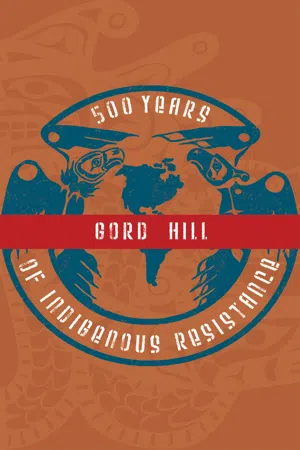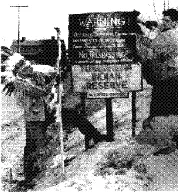![]()
EXTERMINATION AND ASSIMILATION:
TWO METHODS, ONE GOAL
In the early 1900s, the population of Native peoples in North America had reached their lowest point. In the U.S. alone this population had declined to some 250,000. As in Canada, Native peoples had been consigned to largely desolate land areas and the process of assimilation began through government agencies such as the Bureau of Indian Affairs. Here too, residential schools, criminalization of Native cultures, and control of political and economic systems were the instruments used. Native peoples, like those in Canada, were viewed as obstacles to be crushed in the drive for profits.
In both countries, resistance to this assimilation continued in various forms: potlatches and sun-dances were continued in clandestinity and the elected band councils opposed. As well, Native peoples began forming organizations to work against government polices. In 1912, the Alaska Native Brotherhood was formed by the Tlingit and Tsimshian at Sikta. That same year, the Nishga Land Claims Petition was presented to the Canadian government concerning the recognition of aboriginal title; no treaties had or have been signed with First Nations in BC [as of 1991]-with the exception of a north-eastern corner of BC included in Treaty No. 8 and some minor treaties on Vancouver Island. Yet Natives in BC had found themselves dispossessed of their territory and subjected to the Indian Act. In 1916 the Nishga joined with the interior Salish and formed another inter-tribal organization, the Allied Tribes of BC. Funds. were raised, meetings held, and petitions sent to Ottawa. In 1927, a special Joint Committee of the Senate and House of Commons found that Natives had “not established any claim to the lands of BC based on aboriginal or other title.” 41 That same year Section 141 was added to the Indian Act prohibiting raising money and prosecuting claims to land or retaining a lawyer.
Indigenous Land Within United States, 1492-1977
While the European nations would lead the world into two great wars for hegemony, political instability and economic depredations formed the general pattern in South and Central America. Military regimes backed by U.S. and British imperialism carried out genocidal policies and severe repression against Indigenous peoples. As in North America, Indigenous peoples were consigned to desolate reserve lands where the state or missionaries retained control over political, economic, social and cultural systems. However, in contrast to the colonization of North America, where Native peoples were viewed as irrelevant to economic expansion, the Indians of South and Central America remained as substantial sources of exploited labour. With the large-scale investments from the imperialist centres in the form of loans, the export of primary resources took priority. The ‘rubber boom’ was one example, with tens of thousands of Indians dying in forced labour, relocations, and massacres carried out by major land owners, companies, and hired death squads.
In the wake of the rubber boom, Colombia, Ecuador and Peru became battlegrounds for a war between oil companies. Subsidiaries of Shell and Exxon fought for exploration rights in the Amazon, even to the extent of becoming involved in a border war between Ecuador and Peru in 1941... In Brazil...87 Indian groups were wiped out in the first half of the 20th century from contact with expanding colonial frontiers—especially rubber and mining in the northwest, cattle in the northeast, agriculture in the south and east, and from road building throughout all regions. 42
While policies of forced assimilation were occasionally articulated, military and paramilitary forces were to remain an essential part of controlling Native communities and opening up territories to exploitation. The most violent manifestation of this repression came in El Salvador in 1932, where as many as 30,000 people, primarily Indian peasants, were massacred following an uprising against the military dictatorship that took power the year prior. While the massacres were carried out under the guise of “anti-communism”, U.S. and Canadian naval vessels stood offshore, and U.S. Marines in Nicaragua were put on alert. However, as the U.S. Chief of Naval Operations later testified before Congress, “it was found unnecessary for the U.S. ...and British forces to land, as the Salvadorian government had the situation in hand.” 43 During the same period in Colombia, the Indian leader Quintin Lame helped initiate struggles for land and developed an Indigenous philosophy of resistance; in the early 1980s, his legacy would live on in the Indian guerrilla group “Commando Quintin Lame”. Gonzalo Sanchez was another leader who helped organize the Supreme Council of Indians in Natagaima, Colombia, in 1920.
After World War II, significant changes in the world capitalist economy would see increased penetration of the Amazon and other lowland forest regions in South America. In the post-War period, the U.S. emerged in a dominant position in the world economy and would subsequently move to open up markets for economic expansion. In Western Europe and Japan, as part of the Marshall Plan, some $30 billion in loans and aid was pumped into the economies to rebuild these countries as U.S. markets and, not insignificantly, as a base of containment against the USSR (military alliances were also created through NATO and SEATO, positioned against the East Bloc).
South and Central America were to be brought firmly under U.S. control, a process begun during the early 1900s as the U.S. moved to replace Britain as the dominant imperialist nation in the region, even paying off debts owed to Britain. As part of the U.S. post-War plans, South and Central America would also receive billions of dollars in direct financial aid from the U.S. and from private transnational banks. This aid allowed the “underdeveloped” countries to industrialize by importing modern technology from the U.S. (in fact, as part of U.S. financial aid, the loans had to be spent in the U.S.). The enormous debts incurred in this process guaranteed dependence and opened up these countries to multinational corporations. As well, international organizations such as the World Bank, International Bank for Reconstruction and Development, and the Agency for International Development (AID) were formed to provide multilateral funding aimed largely at the agro-export sectors, resource extraction, hydro-electric projects and infrastructure (roads, communications, etc.) necessary for the development of those industries. Linked to this “aid” scheme is the International Monetary Fund, which doesn’t fund specific projects but instead steps in with balance of payments support when a country is unable to pay its debts.
These projects and the overall industrialization opened up areas for further exploitation; penetration of areas such as the Amazon and large-scale expropriations accelerated in the 1960s, further devastating Indigenous peoples and leading to renewed campaigns of extermination.
Of course, all this economic restructuring did not occur without growing resistance. With growing movements against imperialism, including peasant unions, students, workers, guerrillas and Indians, a substantial part of the “aid” included military training, weapons, and equipment. U.S. Special Forces troopers were not only in Southeast Asia, they were also quite busy in Central America, training death squads and directing massacres. As part of an overall counterinsurgency campaign, the militarization precipitated an upward spiral of violence. In Guatemala alone, between 1966–68, some 8,000 people were slaughtered by Guatemalan soldiers under the direction of U.S. Green Beret advisors; U.S. pilots flew U.S. planes on bombing missions. Paramilitary groups/death squads hunted down “subversives” in collaboration with the government, military, multinationals, and land-owners.44 The main targets of this campaign, dubbed “Operation Guatemala”, were the Mayan peoples.
Another aspect of the counter-insurgency plans was that of population control. Primarily the focus of U.S. state-funding, the Agency for International Development (AID) was established in 1961. Using the false pretext of “over-population problem”, instead of imperialism, as the cause of mass poverty and starvation, population control came to be championed as the most important dilemma facing the “modern world”. Under the guise of “family planning”, AID began funding for a wide-range of public and private organizations, foundations, and churches who provided training, equipment, and clinics for birth control programs. Between 1968 and 1972, “funds earmarked for population programs through legislation and obligated by AID amounted to more than $250 million”.45 South America received the largest percentage of this funding. Besides educational material, birth control pills, IUDs, and other pharmaceuticals developed by a profitable gene and biotechnology industry in the imperialist centres, the main thrust of population control remains sterilization. Between 1965–71, an estimated 1 million women in Brazil had been sterilized.46 In Puerto Rico, 34% of all women of child-bearing age had been sterilized by 1965.47 Between 1963– 65, more than 40,000 women in Colombia had been sterilized.48 In contrast to these programs in the “Third World”, the imperialist centres see restrictions on abortion and struggles for women’s reproductive choice. But even here there is a double standard for non-European women:
Lee Brightman, United Native Americans President, estimates that of the Native population of 800,000 (in the U.S.), as many as 42% of the women of childbearing age and 10% of the men...have been sterilized... The first official inquiry into the sterilization of Native women...by Dr. Connie Uri...reported that 25,000 Indian women had been permanently sterilized within Indian Health Services facilities alone through 1975... According to a 1970 fertilization study, 20% of married Black women had been sterilized, almost three times the percentage of white married women. There was a 180% rise in the number of sterilizations performed during 1972–73 in New York City municipal hospitals which serve predominantly Puerto Rican neighbourhoods. 49
Similar results were found in Inuit communities in the Northwest Territories. Clearly, “overpopulation” is not an issue in North America, nor is it in South or Central America. Rather, it is a method for reducing specific portions of the population who would organize against their oppression and who have no place in the schemes of capital. In other words, “It is more effective to kill guerrillas in the womb”.
Of all the South American countries that underwent massive industrialization after World War II, Brazil is probably the most well known. Following a 1964 coup backed by the U.S., IMF and multinationals, foreign investment rose steadily. Between 1964–71, over $4 billion had been pumped into Brazil through the World Bank, AID, IDB, and others. 50 Between 1900–57, the Indigenous population of Brazil had declined from over 1 million to less than 200,00051 through the rubber boom, ranching, and mining industries. Following the 1964 coup and the rise in foreign investment, the penetration of the Amazon region in particular was increased. As these industries invaded even more Indian lands, a renewed campaign of extermination accompanied them. Indians were hunted down by death squads, their communities bombed and massacred, and disease epidemics purposely spread through injections and infected blankets. In the 1960s alone,
Of the 19,000 Monducurus believed to have existed in the 30s, only 1200 were left. The strength of the Guaranis had been reduced from 5,000 to 300. There were 400 Carajas left out of 4,000. Of the Cintas Largas, who had been at...



